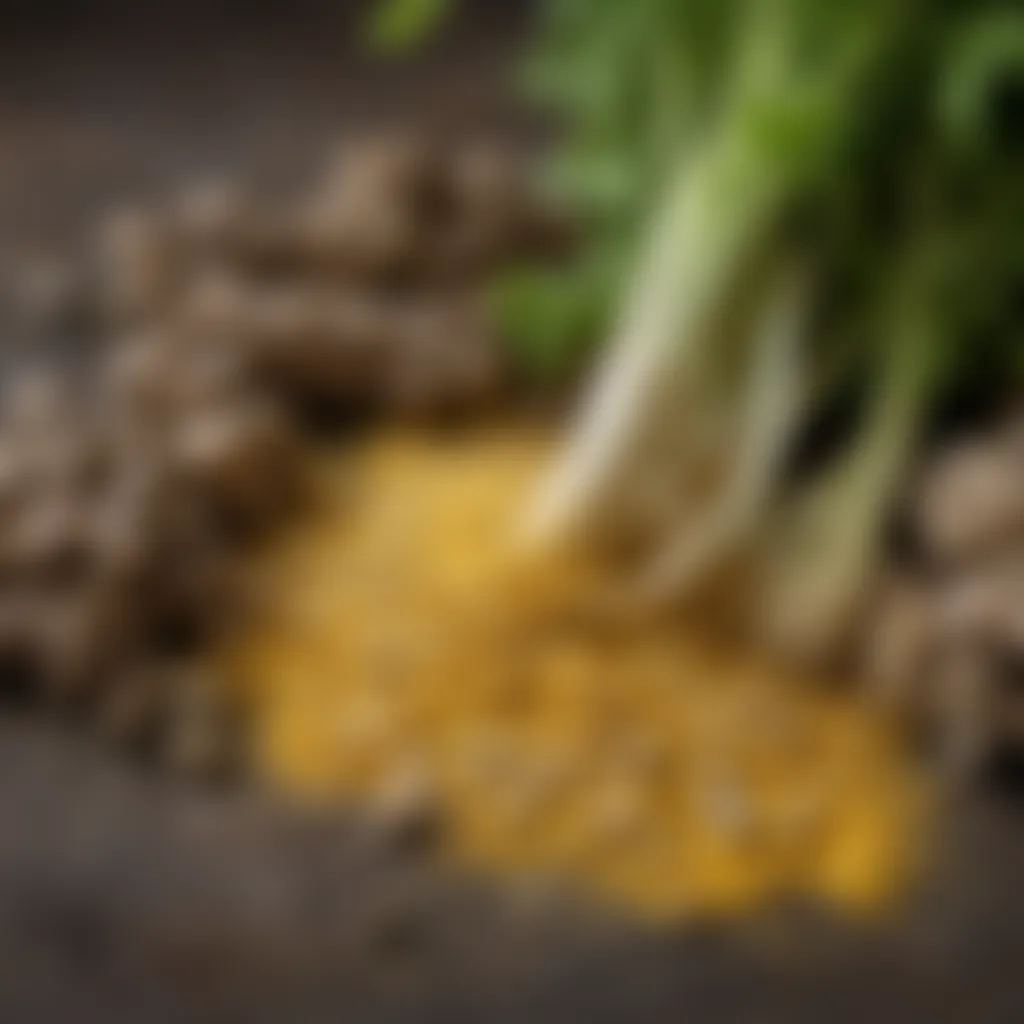Exploring the Intricacies of Mustard and Horseradish


Intro
Mustard and horseradish have unique flavors that add depth to many dishes. The journey of understanding these ingredients involves not just their tastes, but also their historical and culinary significance. This examination focuses on how mustard complements horseradish. Both ingredients have individual characteristics that interact in various recipes. Many people overlook the health benefits that accompany these condiments. Delving into this topic allows us to appreciate their roles in gastronomy.
Ingredients:
To begin cooking with mustard and horseradish, it's crucial to gather the right ingredients. Here is a list of essential components:
- 2 tablespoons of mustard (options: Dijon, yellow, or whole grain)
- 1 tablespoon of prepared horseradish (adjust to taste)
- 1 teaspoon of honey or sugar (optional, to balance flavor)
- 1 tablespoon of apple cider vinegar (for acidity)
- 1/4 teaspoon of salt (to enhance flavors)
- 1/2 teaspoon of black pepper (freshly ground, for spice)
- 1/4 cup of mayonnaise (for creaminess, if desired)
Preparation Steps:
Preparation is key to an enjoyable dish. The methods used for combining these ingredients will determine the taste and texture. Follow these detailed instructions:
- Measure out the ingredients according to the list. Precision ensures the final flavor balances correctly.
- In a mixing bowl, combine the mustard and horseradish. Stir well to blend flavors before adding other ingredients.
- Add honey or sugar, if using. This balance can create a more complex flavor profile.
- Pour in the apple cider vinegar and mix. This addition helps with the overall acidity.
- Season with salt and black pepper. Taste and adjust seasoning as needed.
- If making a creamier version, fold in the mayonnaise. This can provide a richer texture.
Technical Aspects:
The following details ensure consistent results during preparation:
- Temperature settings: Most ingredients can be used at room temperature, but horseradish may be sharper when cold.
- Timing specifics: The flavors develop over time. Let the mixture sit for about 10 minutes to allow integration.
Cooking Process:
Executing the recipe requires attention to method and timing:
- Prepare your serving dish by choosing a suitable container. A decorative bowl works well for presentation.
- Transfer the mixture from the bowl to the serving dish. Smooth the top for an appealing look.
- Store leftovers in an airtight container. Keep it refrigerated for up to two weeks.
Troubleshooting Tips:
Cooking can pose challenges. Here are solutions for common issues:
- If the mixture is too spicy, add more mayonnaise or honey to neutralize.
- If lacking flavor, increase salt or add a splash more vinegar to enhance taste.
- For a smoother texture, blend using a food processor.
Experimenting with mustard and horseradish opens up new culinary possibilities while deepening flavor comprehension.
Understanding how these ingredients come together enriches both cooking skills and culinary appreciation. Mustard and horseradish not only offer unique tastes but also relay a story through their regional adaptations. This exploration illustrates the nuanced relationship between these two condiments.
Prolusion to Mustard and Horseradish
In this section, we delve into the essential characteristics of mustard and horseradish. Understanding these elements provides a solid foundation for exploring the intricate connections between these two ingredients. By unpacking their distinct flavors, health benefits, and culinary uses, we uncover their importance not only in everyday cooking but also in gastronomic traditions worldwide.
Defining Mustard
Mustard is a condiment derived from the seeds of the mustard plant. Its versatility renders it a staple in multiple cuisines across different cultures. There are many types of mustard, including yellow mustard, Dijon mustard, and whole grain mustard. Each type brings unique flavors and textures to the table. For instance, yellow mustard is mild and tangy, often used on hot dogs and sandwiches. Dijon mustard, in contrast, offers a sharper taste, suited for salad dressings or gourmet dishes. Whole grain mustard is coarser and provides a robust, earthy flavor, ideal for charcuterie or marinades.
Defining Horseradish
Horseradish, on the other hand, is a root vegetable known for its potent flavor and aroma. It belongs to the Brassicaceae family, the same family as mustard. Prepared horseradish can be found in jars, often mixed with vinegar to preserve its heat. Fresh grated horseradish is also popular and delivers a strong, pungent flavor that can enhance various dishes, especially meats and seafood. Horseradish sauce, typically a blend of grated horseradish, cream, and vinegar, offers a rich, creamy texture while retaining the root's characteristic bite.
Historical Context
The historical significance of mustard and horseradish ebbs and flows throughout various cultures. Mustard seeds were used in ancient Egypt and Rome, where they were valued for both culinary and medicinal purposes. In some traditions, mustard symbolizes strength and courage. Meanwhile, horseradish had its roots in Europe, where it gained popularity in the Middle Ages as a condiment and a medicinal herb. Its use has endured, with horseradish frequently appearing in Jewish cuisine during Passover, symbolizing the bitterness of slavery. Thus, the background of these condiments reflects not just their culinary roles but also their cultural importance.


Flavor Profiles and Culinary Characteristics
In gastronomy, understanding the flavor profiles and culinary characteristics of ingredients is essential. This knowledge guides how we pair flavors, choose cooking methods, and create dishes that resonate with our tastes. When it comes to mustard and horseradish, their distinct flavors offer unique contributions to many recipes. Both ingredients are not only condiments but also components that can elevate a meal. This section delves into the profiles of mustard and horseradish, exploring their distinct tastes and how they interrelate in various culinary applications.
Mustard Profiles
Yellow Mustard
Yellow mustard, often the go-to choice for casual dining, is characterized by its bright color and mild flavor. It brings a tangy sharpness that cuts through rich foods, making it a popular choice for hot dogs and sandwiches. One of the key characteristics of yellow mustard is its vinegar content, which creates a zesty profile while allowing it to complement a variety of flavors. This condiment is accessible to many, making it a staple in households. Its advantage lies in its versatility and the ease with which it can be paired with horseradish. However, some might find its taste too basic compared to other mustard types.
Dijon Mustard
Dijon mustard offers a more refined taste, with a smoother texture and a bit more heat. Originating from the city of Dijon in France, this mustard plays a crucial role in salad dressings and gourmet recipes. Its bold flavor deepens the profile of sauces, enhancing the overall dish. A notable feature of Dijon mustard is its creamy consistency, which blends well with ingredients like oil and vinegar. This characteristic makes it a favored choice in professional kitchens and among culinary enthusiasts. Still, it might overwhelm those who prefer the subtler notes of yellow mustard in some classic dishes.
Whole Grain Mustard
Whole grain mustard stands out with its texture, revealing visible mustard seeds that provide a unique mouthfeel. This mustard type not only offers a complex flavor, combining sweet and spicy notes but also presents a visual appeal in dishes. The primary characteristic of whole grain mustard is that it retains more of the mustard seeds, resulting in a robust texture. This characteristic allows it to serve as an ideal partner with meat dishes, such as roasted meats or artisanal sausages. Whole grain mustard is a popular choice for gourmet applications, but its intense flavor may not suit every palate.
Horseradish Profiles
Prepared Horseradish
Prepared horseradish comes from freshly grated horseradish root mixed with vinegar and salt. This process preserves its bold and pungent flavor, making it a common condiment. A significant advantage of prepared horseradish is its convenience and long shelf-life, allowing cooks to store it easily. It pairs excellently with various meats, reviving classic dishes. However, the intensity of prepared horseradish can sometimes overpower other flavors in a dish.
Horseradish Sauce
Horseradish sauce is a blend of prepared horseradish and cream or mayonnaise. This combination mellows the harshness while retaining the distinctive kick of horseradish. The creamy texture makes it an appealing option for dips or as a condiment for sandwiches and grilled meats. Its smooth consistency allows for versatile usage across multiple culinary settings. However, consumers should note that some brands may contain added sugars or other ingredients that can alter its taste.
Fresh Grated Horseradish
Fresh grated horseradish provides the most potent flavor. The preparation involves grating the root directly before use, delivering an intense and immediate pungency. Its unique feature is that it brings a distinct sharpness that brings freshness to dishes. This freshness is particularly appreciated in seafood applications, like accompanying fish. Yet, working with fresh grated horseradish requires immediate use, as it can lose its pungency when exposed to air for too long.
Interactions Between Mustard and Horseradish
The interactions between mustard and horseradish can create complex flavor profiles, enhancing dishes in interesting ways. Their respective characteristics allow chefs and home cooks to explore a range of tastes, from sharp and tangy to creamy and spicy. Whether incorporated in sauces, dressings, or as side condiments, understanding these interactions means unlocking potential flavor combinations that can elevate a meal.
Culinary Uses of Mustard and Horseradish
The exploration of culinary applications of mustard and horseradish plays a pivotal role in understanding their contribution to gastronomy. Together, these ingredients enhance flavors, provide contrasts in dishes, and offer numerous health benefits. Mustard and horseradish have unique properties that can elevate simple meals and create dishes that are complex in flavor and texture. Considering their shared history and evolving trends in cuisine, their applications warrant careful analysis.
Pairings with Meats
Beef
Beef is a strong and flavorful protein that pairs exceptionally well with mustard and horseradish. The richness of beef complements the tangy sharpness of mustard, while horseradish adds a distinct heat that cuts through the fat. The key characteristic of beef is its hearty nature, which makes it a popular choice for an array of dishes, from roasts to steaks. Mustard acts as both a marinade and a condiment, bringing both flavor and tenderizing properties. However, the only downside could be that strong horseradish may overwhelm the delicate flavors of certain cuts. Therefore, balance is crucial in cooking.
Pork
Pork also shines when paired with these condiments. Its natural sweetness contrasts beautifully with the sharpness of mustard and horseradish. Pork's key characteristic is its versatility. Whether it is ribs, chops, or tenderloin, mustard can be rubbed on before cooking, and horseradish can be served on the side. This ensures a rich and engaging flavor profile. One unique feature is that some pork preparations benefit from sweet mustard, while others may highlight spicier varieties. A disadvantage is that not all cuts may require such bold flavors, potentially masking the meat's natural taste.
Fish
Fish, particularly richer varieties like salmon or tuna, are excellent candidates for mustard and horseradish interactions. The lightness of fish provides a delicate backdrop to the robust flavors of mustard. The key characteristic here is the subtle flavor of the fish enhanced by a tangy mustard glaze or a zesty horseradish sauce. Fish dishes can present a unique feature, like the ability to include mustard seed in additional marinades or dishes. However, one must exercise caution because overly strong horseradish can easily overpower the fish's gentle flavors.


Role in Sauces and Dressings
Mustard and horseradish both play significant roles in sauces and dressings, showcasing their adaptability and enhancing culinary experiences. Mustard serves as a foundational element in dressings like vinaigrettes, adding depth and complexity. Horseradish appears in sauces, enriching flavor profiles. Combining both has become increasingly popular, resulting in creamy blends that provide both bite and tang. Many chefs appreciate the ability to manipulate these condiments to match various dishes, ensuring they cater to diverse palates.
Examples of Dishes Combining Both Ingredients
Several dishes highlight the harmonious combination of mustard and horseradish. A classic example is the steak sandwich, where horseradish sauce is smeared on bread, lending a kick to the hearty beef. Another dish could be mustard-glazed salmon, where a mixture of whole grain mustard and honey enhances the fish's flavor. Roasted pork tenderloin also can be served with horseradish cream, offering a delightful contrast. These combinations create not only delicious meals but also elevate the culinary experience, showcasing the potential of mustard and horseradish in the kitchen.
Health Benefits and Nutritional Aspects
Understanding the health benefits and nutritional aspects of mustard and horseradish is essential in appreciating their roles in our diets. These condiments offer more than flavor; they also provide a range of nutrients and potential health advantages. By examining their respective nutritional compositions and their contributions to overall health, one can better appreciate incorporating these ingredients into daily meals.
Nutritional Composition of Mustard
Mustard seeds are small yet packed with nutrients. They contain significant amounts of vitamins A, C, and K, along with minerals like calcium, magnesium, and potassium. Mustard also has a good amount of dietary fiber, which aids in digestion.
Depending on the type, mustard can have different nutritional profiles. For instance:
- Yellow Mustard: Typically lower in calories and fats, it contains about 3 calories per teaspoon.
- Dijon Mustard: This variety typically has a richer flavor, but also carries slightly more calories and sodium.
- Whole Grain Mustard: This variant is higher in fiber due to the seeds and provides a more robust taste and texture.
Overall, mustard can enhance flavor without adding significant calories, making it a low-calorie option for dressings and marinades.
Nutritional Composition of Horseradish
Horseradish, known for its potent flavor, is also nutritionally favorable. It is low in calories, providing only about 5 calories per teaspoon. Importantly, horseradish contains vitamins C and B6, as well as folate. Its high water content aids in hydration as well.
Moreover, horseradish is rich in glucosinolates, compounds linked to various health benefits. Some of these beneficial compounds may contribute to its pungent taste and smell as well. The active ingredient, allyl isothiocyanate, presents a strong heat and is responsible for horseradish's distinctive spiciness.
Potential Health Benefits
Anti-inflammatory Properties
The anti-inflammatory properties of mustard and horseradish are noteworthy. Both condiments contain compounds that may help reduce inflammation in the body. This characteristic is significant because chronic inflammation is linked to various health issues, including heart disease and cancer.
The key characteristic here is the presence of glucosinolates in horseradish, which may help in diminishing inflammation. This makes horseradish a popular choice for those seeking alternatives to traditional anti-inflammatory medications.
A unique feature of these properties lies in their natural origin. Using mustard and horseradish in cooking can be a flavorful way to tap into their potential benefits.
Digestive Health
Both mustard and horseradish can positively impact digestive health. The high fiber content in mustard aids in regular bowel movements and can help in alleviating constipation. Horseradish also acts as a digestive aid by stimulating the production of gastric juices, enhancing digestion.
The key characteristic is how these condiments promote a healthy digestive system. They can be beneficial for anyone looking to improve gut health and overall digestive function. Additionally, since they are generally low in calories, incorporating them into a diet does not impose significant caloric intake while enhancing health.
Regional Variations and Cultural Significance
The exploration of mustard and horseradish extends well beyond their flavors and uses. Understanding the regional variations and cultural significance of these ingredients provides deeper insights into their roles in different culinary traditions. This section evaluates how local preferences, historical contexts, and cultural practices shape the way mustard and horseradish are perceived and utilized.
Mustard in Global Cuisines
Mustard is a staple condiment across many nations, with each culture adapting its flavor and form to suit local tastes. In France, Dijon mustard is perhaps the most celebrated version, characterized by its smooth texture and distinct sharpness, often used in vinaigrettes and gourmet dishes.
- Germany showcases a more robust style, with varieties such as sweet mustard, which adds a hint of sweetness that complements sausages and pretzels.
- In India, mustard seeds play a pivotal role in cuisine, where they are often used whole in tempering dishes or ground into a fine paste, delivering a robust kick in curries and pickles.


This diversity illustrates how mustard's application varies significantly based on regional taste preferences and ingredient availability. Such variations enable chefs and home cooks to explore different flavor profiles when incorporating mustard into their culinary creations.
Horseradish Traditions Around the World
Horseradish, while sometimes overshadowed by other condiments, is embraced globally for its pungent flavor and medicinal properties. In Eastern Europe, particularly in Poland, horseradish is often served with traditional dishes like gefilte fish and is an essential component during Passover, symbolizing the bitterness of slavery. This ceremony highlights the ingredient’s deep-rooted significance in cultural practices.
- In the United States, prepared horseradish is commonly found in steak sauces and served with raw seafood. Its hot flavor profile complements the richness of these dishes, enhancing the overall dining experience.
- Conversely, Japanese cuisine utilizes horseradish primarily in the form of wasabi. Although not exactly the same, it serves a similar purpose, adding heat to sushi and sashimi.
Each cultural tradition surrounding horseradish showcases not only how it enriches flavor but also how its historical connections embody shared culinary heritage. The adaptation of horseradish into diverse dishes further exemplifies its versatility and illustrates cultural intersections.
"Both mustard and horseradish reflect the tastes, traditions, and histories of their respective cultures, highlighting the global nature of food and the way ingredients travel and transform."
In summary, understanding these regional variations and cultural significances allows for a broader appreciation of mustard and horseradish. It emphasizes the need for cooks to consider not just a recipe's flavor, but also the cultural narratives that accompany these celebrated condiments.
Contemporary Trends in Mustard and Horseradish Applications
In recent years, the culinary landscape has seen a resurgence of interest in the nuanced applications of mustard and horseradish. Chefs and home cooks alike are increasingly eager to explore innovative ways to incorporate these two condiments into a wide array of dishes. This trend not only emphasizes their versatility but also highlights the growing appreciation for bold flavors in gastronomy.
Mustard and horseradish are no longer confined to traditional uses such as sandwiches or accompaniments for meats. Instead, they are being reimagined in sauces, marinades, dressings, and even desserts. The emergence of artisanal and specialty brands has further fueled this exploration, offering unique flavor profiles that cater to discerning palates. As these trends evolve, understanding contemporary applications becomes essential to maximizing the potential of mustard and horseradish in everyday cooking.
Innovative Recipes
The innovation found in culinary recipes is a key aspect of current trends surrounding mustard and horseradish. Each condiment can enhance dishes with distinctive notes. For instance, mustard can be integrated into salad dressings, providing an acidic punch that pairs well with oils and vinegars. Likewise, horseradish can be incorporated into cream sauces, adding depth and a vibrant kick. Here are a few noteworthy recipes:
- Honey Mustard Roasted Brussels Sprouts: Toss Brussels sprouts with a mixture of yellow mustard, honey, and olive oil before roasting them to perfection.
- Creamy Horseradish Mashed Potatoes: Combine boiled potatoes with butter, cream, and fresh grated horseradish for an exquisite take on a classic side.
- Mustard and Horseradish Vinaigrette: Blend Dijon mustard, horseradish, vinegar, and olive oil for a zesty topping on salads or grilled vegetables.
These examples illustrate the shift in incorporating these ingredients dynamically. The possibilities are endless, as culinary creators continue to push the boundaries of traditional recipes.
Fusion Cuisine
The concept of fusion cuisine has become increasingly prominent within food communities, merging diverse culinary elements to create unique gastronomic experiences. Mustard and horseradish play pivotal roles in this movement. By incorporating flavors from various cuisines, home cooks can create exciting dishes that reflect a blend of cultures.
For instance, Asian-inspired horseradish dipping sauces are gaining popularity, where horseradish is combined with soy sauce and sesame oil, complementing dumplings or sushi. Similarly, mustard-infused shawarma sauces provide a Middle Eastern twist when grilling meats or vegetables, enhancing their flavor profile.
The integration of these condiments into fusion dishes fosters creativity and encourages exploration beyond the norms. As such, regional variation translates into the broader culinary tapestry, inviting enthusiastic home cooks to experiment with diverse flavor combinations.
The trend of incorporating mustard and horseradish into modern recipes is reshaping the way we think about these ingredients, paving the way for culinary innovation and diversity.
By embracing these contemporary trends, both home cooks and professional chefs can deepen their understanding of mustard and horseradish, unlocking their full potential in creating extraordinary dishes.
Ending
The conclusion serves as a pivotal point in the exploration of mustard and horseradish. It consolidates the information presented throughout the article, linking all aspects such as flavor profiles, culinary uses, health benefits, and cultural significance.
Understanding the relationship between these two condiments enhances culinary skills and promotes informed choices in cooking. Both mustard and horseradish contribute unique flavors that can elevate a wide range of dishes. This article reveals how simple ingredients can transform meals, providing depth and character.
Summary of Key Points
- Flavor Distinction: Mustard offers a variety of flavors, from the mildness of yellow mustard to the sharpness of Dijon. Horseradish brings a pungent kick, complementing many meats and sauces.
- Culinary Versatility: Both ingredients shine in sauces and dressings, playing a crucial role in enhancing tastes without overpowering other components.
- Health Aspects: They are not only flavorful but also packed with nutrients. Mustard is low in calories, while horseradish has potential anti-inflammatory properties.
- Cultural Significance: Across different regions, both have earned a place of respect. From European cuisine to American BBQ, they adapt and redefine local flavors.
Future Directions for Exploration
Future exploration of mustard and horseradish could engage with several avenues:
- Innovative Dishes: Researching how chefs innovate with these ingredients in contemporary cooking can open doors to new flavors. Recipes combining unexpected elements with mustard or horseradish could be developed further.
- Health Research: Further studies could investigate the health benefits, particularly the impact on digestion and inflammation. More information will support holistic cooking practices.
- Cultural Diversity: A deeper look into the specific uses of mustard and horseradish in various global cuisines could highlight unique traditions. This may involve community-driven projects to document family recipes or encourage fusion cuisine.
- Sustainable Practices: Understanding agricultural practices surrounding mustard and horseradish cultivation may lead to supporting local farmers while promoting sustainability in gastronomy.
"Exploring the nuances of culinary ingredients not only enhances food but enriches lives, offering a deeper connection to the art of cooking."
In summary, as we conclude the discussion, both mustard and horseradish present ample opportunities for further inquiry, cooking experimentation, and health exploration.







